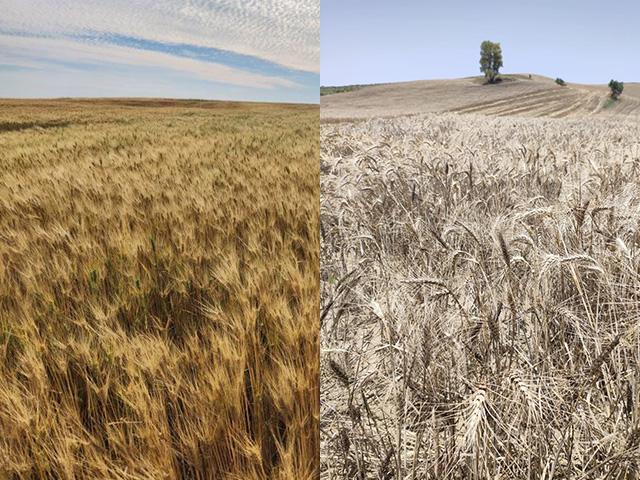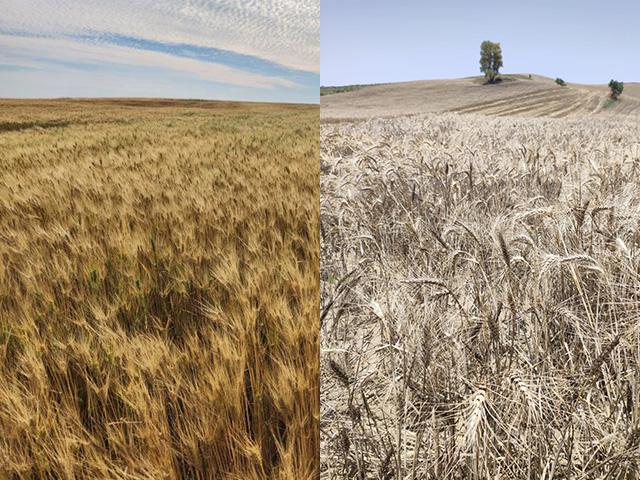Market Matters Blog
Durum: The 2023 Pasta Wheat Supply and Quality in Question
There is a strong likelihood that the Canada durum crop especially, and possibly the U.S. durum crop, may not produce enough durum to meet the demands of the countries that normally import durum for their pasta needs.
In the July 12 Crop Production report, USDA said durum production in 2023 was forecast at 54 million bushels (mb), down 9.9 mb, or 16%, from 64 mb in 2022. Statistics Canada will not release official yield and production estimates until Aug. 29, which will be generated from their model-based approach, but there are private estimates of a crop size approaching 4 million metric tons (mmt), if not lower.
It's not just the quantity that is an issue, there is also concern about the quality. Poor quality would not only be detrimental for exports to key pasta-producing countries such as Italy, but also would be detrimental to U.S. and Canada pasta makers.
As a reminder, durum is a class of wheat that is very dense and high in protein. One 60-pound bushel makes about 42 pounds of pasta or roughly 210 servings of spaghetti. Durum wheat kernels are amber-colored and larger than other wheat kernels and look like (and taste like) a pasta noodle. The very best choice durum is at least 85% vitreous kernels, (HVAC) and 61-pound test weight. U.S. No. 1 Choice Hard Amber Durum (top milling quality) is key to the perfect pasta.
ITALY FACING POOR QUALITY ISSUES
The durum crop in Italy is facing quality issues after excessive rains fell from May 1 to mid-June (the equivalent of five to six months in only 40 days) and they will need to import enough of the top quality to offset their poor quality. I spoke via email with Rossella Polito, an Italian farmer and durum wheat producer in Apulia in South Italy. She manages an account on the X platform, formerly known as Twitter, called Spiga Dorata (which in Italian means golden wheat ear) with news related to durum wheat and focuses on aspects of the global durum market.
"This year, unfortunately, we had some serious issues on our national durum crops in flowering, earing (follows boot stage) and filling stage -- and even until ripe and harvest -- related with bad weather and too abundant and exceptional rains for many consecutive weeks, all concentrated in the months of May and June for many consecutive days and widespread all over Italy. So, no area of production of our durum wheat was spared by bad weather issues," said Polito.
"Honestly, many of us didn't know what exactly to expect once the harvest finally started. However, somewhat surprisingly, there doesn't seem to have been a vertical drop in national production. Not all fields were affected by poor quality either, but a large part, yes. And a large part didn't have the high yields expected in April before it started to rain, but still a decent one. However, as the harvest proceeded, the later areas began to give lower and lower yields. But it is quality that is our main concern this year.
"Kernels in most cases has very low hectolitre weights (test weight) with values below 80 kg/hl, and in some cases even well below 70, thus resulting in a very low milling yield. Furthermore, especially in northern and central Italy, there have also been problems with black point kernels (a characteristic particularly unwelcome to the pasta industry). So much so that it was necessary to insert the maximum percentage limits of this bad qualitative parameter in the new weekly price lists of the principal local Italian commodity exchanges (Bologna, Foggia). Protein wasn't a big concern as it was low hectolitre weights. All in all, protein values weren't as disastrous as one might think, even if the rains certainly influenced the washing of kernels and color," added Polito.
Polito told me that the poor quality combined with low final stocks from the past commercial season the price of durum wheat in Italy recently began to "rise furiously," especially the best quality category, "Fino," reaching a maximum of 460 euros per metric ton ($507 USD) Aug. 2 at Foggia versus the first new crop bid of 335 euros/mt ($368 USD) on its first new crop price on June 28. At Bologna, the price jumped to 425 euros/mt ($468 USD) versus 345 euros/mt ($379 USD).
P[L1] D[0x0] M[300x250] OOP[F] ADUNIT[] T[]
"The price gap between the best and worst grades categories has widened with a lower price in some cases, also considerably as in Bologna, where last week the price gap reached over 100 euros/mt ($110 USD) between the 'Fino' and 'Mercantile' categories and 150 euros/mt ($165 USD) between 'Fino' and 'Sotto Mercantile' (under/below merchant quality)," added Polito.
"Now our durum exchanges in Italy closes for about two to three weeks for summer holidays, but all the eyes of farmers and market operators are focusing to North America and the big problems that seem to arise on your durum wheat crops due to drought, and what this could mean for the future of our domestic prices when the market will open again at the end of August," said Polito.
"Now, one thing is certain: Italy desperately needs to import durum wheat this year more than usual, especially durum of good quality, to partially balance all those our poor quality and declassed durum wheat consignments considered unsatisfactory by the milling and pasta-making industry. Let's see what will happen and above all who can satisfy such a big demand with a Canadian crop that seems to be deteriorating more and more. It will be a very interesting year for farmers with a crop to sell."
CANADA DURUM CROP PRODUCTION/QUALITY IN QUESTION
The Canadian durum situation points to tighter supplies for the year ahead, while at a time when Canadian exports are needed to meet global demand," said Cliff Jamieson, DTN Canadian Grains Analyst. "The Canadian Grain Commission reports commercial stocks of 220,500 metric tons as of week 52, or July 31, while assuming farm stocks end at a similar volume as held one year ago at 83,000 mt, total ending stocks would be roughly 300,000 mt, down 47% from the previous year. As a result, ending stocks, or 2023-24 beginning stocks, could be estimated at the lowest volume on record."
Jamieson said that the Southern Prairies have faced challenging weather conditions through the growing season. "Agriculture and Agri-Food Canada (AAFC) reports precipitation across the Southern Prairies, from April 1 through Aug. 3, ranging from below 40% of normal across areas of southern Alberta, with the best case being 85% to 115% of normal for a small area of southern Saskatchewan. AAFC also reports soil moisture as of July 31 across almost all of the southern prairies at less than 40% of normal.
"High temperatures were also an issue for southern areas. A look at Environment Canada data for Swift Current, Saskatchewan shows 11 days above 30 C (86 F) from July 1 through August 4, with a high of 37 F (98.6 F). The same period for Lethbridge, Alberta shows 14 days above 30 C, with a high of 36.4 C or 97.5 F. Saskatchewan Agriculture shows the crop condition for durum estimated at 87% good to excellent as of May 29, falling to 42% good to excellent as of June 26 and to 16% as of July 24, with 51% rated poor to very poor. In comparison, condition on July 26, 2021, was estimated at 11% good to excellent, with 60% rated poor to very poor, a year when the national average yield fell to 20.2 bushels per acre, down 50% from the previous five-year average. Alberta Agriculture has estimated the province's durum condition at 30.3% G/E as of July 25."
Jamieson noted that, when the new crop durum supplies are added to a historically low carry-in, total supplies may not be significantly higher than the 3.853 mmt estimated in 2021-22. "This volume will fall well short of 2022-23 demand of 5.1 mmt of exports and 660,000 mt of domestic disappearance (5.760 mmt), as reported by the Canadian Grain Commission. Prices have reacted as one would expect. Pdqinfo.ca reports the average spot bid for Southwestern Saskatchewan falling to a low of $390.70/mt ($10.63/bushel CAD) as of July 4, while rising almost every day since to $493.17/mt ($13.42/bu CAD) as of Aug. 4," said Jamieson.
The earliest crop is starting to come off in southern locations, while producers will be slow to market durum.
NORTH DAKOTA DURUM
In their weekly crop progress update, the North Dakota Wheat Commission noted that, through the week ending Aug. 1, much of the durum-producing area of North Dakota did receive some moisture during that week. "Right now, most producers indicate the crop is showing average yield potential. Crop condition ratings show 55% of the durum is in good-to-excellent condition and 14% is rated in poor-to-very-poor condition, below the prior week's ratings. While the crop is slightly ahead in terms of development, harvest is not expected to be in full force for another couple of weeks. In Montana, 27% of the crop is rated good to excellent and 24% as poor."
Kim Saueressig of McCluskey, North Dakota, said on Aug. 2, "Durum is looking good so far -- really tall stands and looks like a lot of straw. Heads look to have good kernel counts and, from what I can tell, it doesn't look like a lot of disease pressure. Probably be about another week to 10 days 'til we try to harvest. I just got started on barley on Tuesday and if the yields are anything like the barley for the durum, I'll be very satisfied."
Jeremy Burkhart, CEO of United Quality Cooperative in New Town, North Dakota, and president of the North Dakota Grain Dealers Association said, "The crops were starting to suffer from lack of moisture in July and the heat we had on top of it. Now, as we are getting close to harvest, we had an all-day soaker on Aug. 4 in pretty much all the durum area. I don't think the durum was ripe enough to get too affected from the rain, but we will see once the combines start rolling. The run-up in durum price has the farmers' attention, but they are bulled up and not selling."
In other words, as was common among durum farmers in North Dakota back when I traded durum, the bins will be filled and then "padlocked" until the price gets to a point they will be willing to unlock those bins and sell.
Here is some from NDWC on the difference in durum grades: https://www.ndwheat.com/…
Foggia, Italy Price of various durum grades as of August 2: https://teseo.clal.it/…
Durum wheat test weight conversion chart: https://www.grainscanada.gc.ca/…
Unit Conversion Factors: http://www.cawheat.org/…
Mary Kennedy can be reached at Mary.Kennedy@dtn.com
Follow her on Twitter @MaryCKenn
(c) Copyright 2023 DTN, LLC. All rights reserved.






Comments
To comment, please Log In or Join our Community .